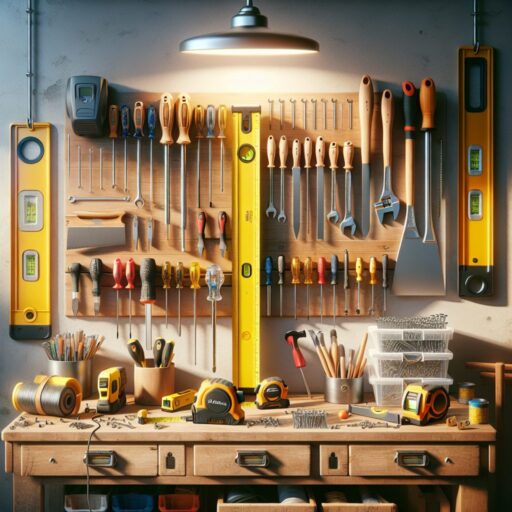Ultimate Guide to Home Improvement Tools: Types, Uses, and Importance
Home improvement tools are items that help you fix, build, or improve your house. They make tasks easier and faster. These tools are used by professionals and regular people alike. You can use them to repair broken things, decorate your home, or even create new furniture. Having the right tools is important for any project. In this article, we will explore different types of home improvement tools, how to use them, and why they matter. By the end, you’ll know which tools to keep at home and how they can help you.

Basic Tools Every Home Should Have
![]()
Some tools are essential for every home. These are basic tools you can use for small repairs or projects. They are easy to find and usually affordable.
- Hammer: A hammer is great for driving nails into wood or removing them. It is one of the most common tools.
- Screwdriver: Screwdrivers help you tighten or loosen screws. They come in two main types: flathead and Phillips head.
- Measuring Tape: This tool helps you measure spaces accurately. It is useful for hanging pictures or cutting materials.
- Pliers: Pliers help you hold or bend small objects. They are also good for cutting wires.
- Utility Knife: A utility knife helps you cut through tough materials like cardboard or plastic.
For example, if a picture frame falls off the wall, you can use a hammer to reattach it. Or if a screw on your chair gets loose, you can grab a screwdriver and fix it quickly. According to a survey, over 80% of homeowners own these basic tools because they are so useful.
Having these tools means you can handle small problems without calling for help. Keep them in a toolbox or drawer so they’re always easy to find.
Tools for Painting and Decorating
![]()
If you want to change the color of your walls or add decorations, you need specific tools. These tools make painting and decorating much easier.
- Paintbrushes: Paintbrushes come in different sizes. Use smaller ones for details and larger ones for big areas.
- Paint Roller: A paint roller helps cover large areas quickly. It leaves a smooth finish.
- Painter’s Tape: Painter’s tape keeps paint from getting on areas you don’t want painted.
- Drop Cloth: A drop cloth protects your floors and furniture from paint spills.
- Putty Knife: This tool helps fill holes or cracks in walls before painting.
For example, imagine you want to paint your bedroom blue. First, you use painter’s tape to protect the edges of the ceiling and windows. Then, you use a paint roller to cover the walls and a small brush for corners. Finally, you clean up using the drop cloth. Simple tools make the job look professional.
Statistics show that 75% of homeowners try DIY painting. These tools make it possible for anyone to get started easily.
Power Tools for Bigger Projects
![]()
Sometimes, basic tools are not enough. For bigger projects, power tools save time and effort. They run on electricity or batteries and are very effective.
- Drill: A drill helps you make holes or drive screws quickly. It is useful for building furniture or hanging shelves.
- Circular Saw: A circular saw cuts through wood, metal, or plastic easily. It is great for building projects.
- Sander: A sander smooths rough surfaces, like wooden chairs or tables.
- Nail Gun: A nail gun drives nails automatically. It is faster than using a hammer.
- Jigsaw: A jigsaw cuts shapes into wood or other materials. It is perfect for creative projects.
For example, if you want to build a bookshelf, you can use a circular saw to cut the wood and a drill to assemble it. Power tools make such tasks quicker and more precise. Studies show that 60% of DIY enthusiasts own at least one power tool.
However, power tools can be dangerous if not used properly. Always read the instructions and wear safety gear like gloves and goggles.
Tools for Fixing Plumbing Issues
![]()
Plumbing problems can happen unexpectedly. Having the right tools can help you fix minor issues without calling a plumber.
- Plunger: A plunger helps unclog sinks, toilets, and drains.
- Pipe Wrench: A pipe wrench tightens or loosens pipes.
- Drain Snake: This tool removes blockages from pipes.
- Teflon Tape: Teflon tape seals pipe threads to prevent leaks.
- Basin Wrench: A basin wrench reaches tight spaces under sinks.
For instance, if your kitchen sink gets clogged, a plunger can often solve the problem. If there is a small leak in a pipe, wrapping it with Teflon tape might stop the water until a permanent fix is made. A study found that 50% of plumbing problems can be solved with basic tools like these.
These tools are affordable and easy to use. Keeping them handy can save you time and money.
Tools for Outdoor Improvements
![]()
Your yard or garden also needs care. Special tools can help you maintain outdoor spaces and make them look beautiful.
- Shovel: A shovel helps dig soil for planting trees or flowers.
- Pruning Shears: These trim bushes and plants to keep them neat.
- Rake: A rake collects leaves and debris from your yard.
- Lawn Mower: A lawn mower cuts grass evenly.
- Hose: A hose waters plants and cleans outdoor areas.
Imagine you’re planting a vegetable garden. You use a shovel to dig holes, pruning shears to cut dead branches, and a hose to water everything. With these tools, outdoor projects become manageable and fun.
Gardening statistics show that 42% of households grow their own plants. These tools make outdoor work enjoyable and productive.
Safety Equipment for Using Tools
![]()
Using tools can sometimes be risky. Safety equipment protects you while working on projects.
- Gloves: Gloves protect your hands from sharp objects or chemicals.
- Goggles: Goggles shield your eyes from dust and flying debris.
- Helmet: A helmet protects your head during construction work.
- Face Mask: Face masks keep you from breathing in harmful particles.
- Ear Protection: Earplugs or earmuffs reduce noise from loud tools.
For example, when using a circular saw, wearing goggles and ear protection is essential. Statistics show that about 30% of home improvement injuries happen due to lack of safety gear.
Always prioritize safety. It ensures you can complete your projects without harm.
Organizing and Storing Your Tools
![]()
Keeping your tools organized makes them easier to find and use. Proper storage also extends their life.
- Toolbox: A toolbox keeps small tools in one place.
- Pegboard: A pegboard allows you to hang tools on a wall for easy access.
- Shelves: Shelves store larger tools like drills or saws.
- Labels: Labeling drawers or boxes helps identify tools quickly.
- Cleaning: Cleaning tools after use prevents rust and damage.
For instance, if you have a toolbox with labeled compartments, finding a screwdriver becomes simple. Statistics show that organized tools increase productivity by 20% during projects.
Take a few minutes to organize your tools after every project. It saves time and keeps your workspace tidy.
Conclusion: Why Home Improvement Tools Matter
![]()
Home improvement tools are valuable for everyday tasks and big projects. Basic tools like hammers and screwdrivers handle small fixes. Painting tools help you beautify your home. Power tools make large jobs faster and easier. Plumbing tools solve common issues, while outdoor tools keep your yard looking great. Safety equipment protects you during work, and proper organization keeps tools ready to use.
Whether you’re fixing a leaky faucet or building a table, having the right tools is key. They save time, money, and effort. Start building your tool collection today, and you’ll be ready for any home improvement challenge!
